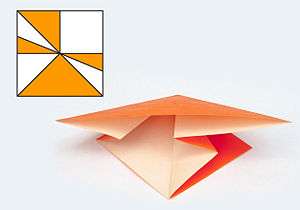Maekawa's theorem
Maekawa's theorem is a theorem in the mathematics of paper folding named after Jun Maekawa. It relates to flat-foldable origami crease patterns and states that at every vertex, the numbers of valley and mountain folds always differ by two in either direction.[1] The same result was also discovered by Jacques Justin[2] and, even earlier, by S. Murata.[3]

Parity and coloring
One consequence of Maekawa's theorem is that the total number of folds at each vertex must be an even number. This implies (via a form of planar graph duality between Eulerian graphs and bipartite graphs) that, for any flat-foldable crease pattern, it is always possible to color the regions between the creases with two colors, such that each crease separates regions of differing colors.[4] The same result can also be seen by considering which side of the sheet of paper is uppermost in each region of the folded shape.
Related results
Maekawa's theorem does not completely characterize the flat-foldable vertices, because it only takes into account the numbers of folds of each type, and not their angles. Kawasaki's theorem gives a complementary condition on the angles between the folds at a vertex (regardless of which folds are mountain folds and which are valley folds) that is also necessary for a vertex to be flat-foldable.
References
- Kasahara, K.; Takahama, T. (1987), Origami for the Connoisseur, New York: Japan Publications.
- Justin, J. (June 1986), "Mathematics of origami, part 9", British Origami: 28–30.
- Murata, S. (1966), "The theory of paper sculpture, II", Bulletin of Junior College of Art (in Japanese), 5: 29–37.
- Hull, Thomas (1994), "On the mathematics of flat origamis" (PDF), Proceedings of the Twenty-fifth Southeastern International Conference on Combinatorics, Graph Theory and Computing (Boca Raton, FL, 1994), Congressus Numerantium, 100, pp. 215–224, MR 1382321. See in particular Theorem 3.1 and Corollary 3.2.